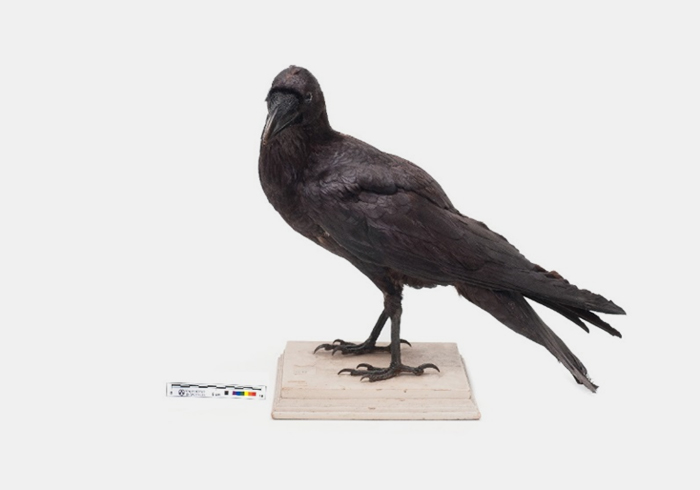Common raven (Corvus corax). VER0000040. Historical collection of taxidermied birds of the University of Valencia.

This month we present the corvid par excellence, the largest crow (Corvus corax) within its family (Corvidae). The great raven is distributed throughout practically the entire northern hemisphere and has differences in size depending on the region where it is found, with the individuals of the populations located further north being of a larger size and beak. Totally black in color, it can confuse us with its congener the raven (Corvus corone) of smaller size and different caudal morphology, among others.
Due to their size and dark coloration, as well as their hoarse cry and scavenging habits, it is common to find these large passerines in the mythologies and popular stories of the northern hemisphere, considered beneficial by some and an evil being by others, bearer of bad omen. Thus, in Norse mythology we find Hugin and Munin, accompanying the god Odin and representing "thought" and "memory". Other cultures such as the Inuit and the Siberian believe that the Raven is the creator of the world and that thanks to him, humans learned to live on the planet. Just as in Asia and North Africa we find the famous three-legged raven representing the powerful Sun. Its bad fame comes from the ancient writings of the Bible, where ravens in some passages were synonymous with bad omens and conspiracies, showing it as a merciless animal that does not hesitate to extract the eyes from the sockets of fallen humans (Proverbs 30,17). Cruel image of these individuals that has passed to our times, reflecting the idea in some of the best known works, such as "The Raven" by Edgar Allan Poe, or "The Birds" by Hitchcock. Appreciated and hated alike throughout history, they were well received in the new cities since their food kept the streets clean thanks to their omnivorous and opportunistic diet, however, later during the 19th century many of them were eliminated, branded as be a threat to livestock. Everything out of reality.
The raven is an omnivorous and opportunistic animal that varies its diet depending on the location it is in and the time of year. In cold regions with the presence of wolves (Canis lupus) it is not uncommon to see them following packs of these on hunts to take advantage of the carrion they leave behind. So don't worry, your eyes are not what they most want to taste, relax in their presence and contemplate them with admiration. Hate crowns? Never more.

















